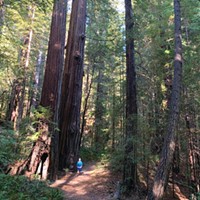
Photo via Humboldt Redwoods State Park, public domain
In the fall of 1926, John D. Rockefeller Jr. (far left) and Newton Drury (far right) picnicked in what would become the Rockefeller Forest. Junior's 11-year-old son David is closest to the camera. Note the chef and waitress at back.
[
{
"name": "Top Stories Video Pair",
"insertPoint": "7",
"component": "17087298",
"parentWrapperClass": "fdn-ads-inline-content-block",
"requiredCountToDisplay": "1"
}
]
Should our lives be judged by the best or the worst of our actions? With most of us, I suppose it's a bit of a crapshoot, deciding which of our many ups and downs would count as "best" or "worst." With others, it's obvious. Take the case of John Davison Rockefeller Jr. (1874 – 1960). Youngest child of John D. Rockefeller, the world's richest man at the time, "Junior" was born to wealth. His occupations as listed by Wikipedia sum up his checkered life: financier, philanthropist.
The worst of Junior's life was his involvement in the Ludlow Massacre of April 1914. Despite divesting his interest in his father's companies, he maintained a controlling interest in the Colorado Fuel and Iron Co. When the United Mine Workers declared a strike against the company due to horrific working conditions, a long period of unrest culminated in the massacre of at least 20 men, women and children at a camp occupied by the strikers. Subsequent hearings never established exactly who was responsible but Junior was heavily implicated. Soon after, he attempted to make amends by meeting with the miners and their families and listening to their grievances, an unheard of practice at the time. According to Mackenzie King, Canadian Prime Minister and close friend of Rockefeller, this was "a turning point in Junior's life, restoring the reputation of the family name; it also heralded a new era of industrial relations in the country." His interest in philanthropy redoubled after Ludlow.
Of local interest, we can thank him for the preservation of 16 square miles of perhaps the finest stand of virgin redwoods (Sequoia sempervirens) anywhere. Today, the Rockefeller Redwood Forest is crown jewel of Humboldt Redwoods State Park. While his vast philanthropy also benefited many other organizations, nationally and internationally (including Margaret Sanger's nascent birth control movement and the United Nations, whose headquarters stands on land donated by him), I consider Junior's original donation to the Save the Redwoods League (SRL) the very best action of his life, in that it protected in perpetuity some of the oldest, most beautiful, trees on Earth.
The league was founded in 1918 by three wealthy, influential men: lawyer Madison Grant and paleontologists Henry Osborn and John Merriam. To our modern eyes, it's strange that these three ardent conservationists were also enthusiastic proponents of the racist eugenics theories of the time, with Grant working with the Nazis ("Removing a Monument to a Eugenicist Nazi Collaborator," July 1, 2021.) Still, in creating the SRL, they were the original catalysts in the fight to save the redwoods, as was Newton Drury, an advertising executive hired early on by the League. Drury soon became a key player, negotiating with the Pacific Lumber Co., owners of most of the redwood forests along the South Fork Eel and Bull Creek, delaying logging until funds could be raised to purchase the trees. (He later became director of the National Park Service, which is why today you drive on the Newton Drury Parkway through the Prairie Creek area in Redwood National and State Park.)
In 1926, Drury and other SRL leaders drove J.D. Rockefeller, Jr. in an open-top car through the great stands of redwoods of Lower Bull Creek Flat before feting him at a picnic beneath the towering trees. It was the league's way of saying thank you. Two years earlier, Junior had donated a check for $1 million to the league after being contacted by Drury and Merriam. He'd repeat the gesture in 1929.
It wasn't only men who drove the campaign to save the redwoods, though. Some tough, influential women stepped up to the challenge, as we'll see next week.
Barry Evans (he/him, [email protected]) is haunted by the thought that, while 95 percent of coastal redwoods have been lost to logging, it could easily have been 100 percent.
Comments
Showing 1-1 of 1
more from the author
-
Doubting Shakespeare, Part 1: Stratfordians vs. anti-Stratfordians
- Apr 25, 2024
-
A Brief History of Dildos
- Apr 11, 2024
-
Eclipse!
- Mar 28, 2024
- More »
Latest in Field Notes
Readers also liked…
-
Trouble on the Line: The Reality Part 2
- Nov 3, 2022

































